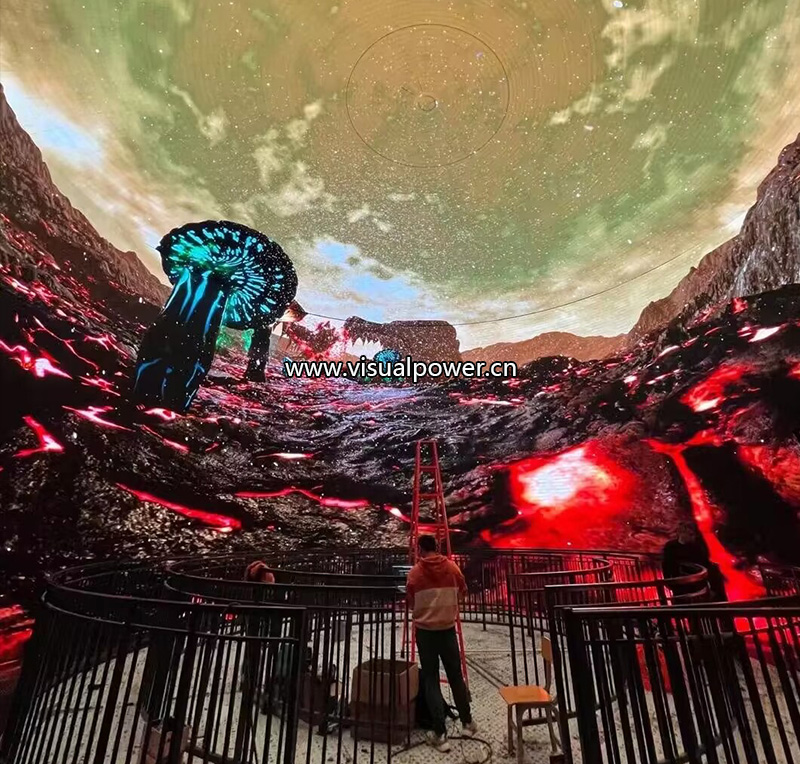Categories
- News (60)
- case study (6)
I have always believed that technology itself is not captivating; what truly touches people’s hearts is the experience hidden behind it. This is also why, after seeing so many screens, I still get excited because of an Immersive LED display. It’s not a cold stack of hardware, but a “portal” that can kick you into another world with one foot.
The first scene that truly struck me with the word “immersive” was not the metaverse or VR, but a concert. The edge of the stage, the ground and the top of the head were all surrounded by LED lights, and the audience seats seemed to be trapped in an entire flowing universe. At that moment, I thought: This is not just watching, but being swallowed up.

Some people understand Immersive LED as “getting bigger and brighter”, but I’m increasingly aware that its essence is the elimination of boundaries. Traditional display is “the audience outside, the content inside”, while the essence of immersion lies in “you are within the content”.
An immersive exhibition project I participated in laid LED screens on the ceiling, floor and even the corners of the corridor. You must pass through the channels formed by the screens before entering the next section of space. This sense of “participation” cannot be measured by technical indicators; it is more like a psychological entry.
Another time, we created a virtual forest-themed experience hall, with screens laid out in front, back, left and right, complemented by spatial sound effects and fragrance diffusion. Standing right in the middle, for a moment I really couldn’t tell the boundary between reality and content. One second you are still standing on the concrete ground, and the next second it seems as if there is the rustling sound of fallen leaves at your feet.
The difficulty of this type of screen has never been in the hardware, but in – what kind of story are you going to tell?
LED screens can fully surround, but if the content is not well done, it would be like piecing an 80-inch TV together in 360 degrees, which would not move people either. Immersive content is not about splicing but about “flow”.
I usually start from an emotional point rather than the picture. For example, if you want to create the feeling of “falling into a dream”, the picture cannot be too jumping. To create an atmosphere of “the rise of technology”, every transition should be like the rhythm of a machine starting up. This rhythm is the unique language that Immersive LED can endow the space with.
I also learned an experience: Leaving blank space is very important. Not all Spaces need to be filled with images. Sometimes, darkening a wall can actually create an emotional contrast. The visual climax is often not the most dazzling second, but the moment when you just emerge from the darkness.
When it comes to technology, I have to mention a few pitfalls that I have personally tested and found “not to be ignored”.
The first one is the joint gap. Immersive LED is most afraid of “perforation”. Even a 0.5mm seam can ruin the sense of spatial continuity. So every time I ask the on-site installation team to confirm with both the naked eye and the camera.
The second is perspective consistency. You can never imagine how a “blind spot” can ruin the experience. Once in a science fiction-themed pavilion, we spliced 270-degree leds in a corner. However, when the audience stood right in the middle, there was one area with a color that was obviously too cold, directly spoiling the “immersion”. It was later discovered that the color calibration logic of the control system was not uniform.
Thirdly, the sound effect system should be designed collaboratively. Don’t think that LED has nothing to do with speakers. The immersive “envelopment” effect is achieved through the combined efforts of vision and hearing. I’ve seen too many projects where the LED is made to perfection, but the background sound is like a radio, completely out of place.
I have always believed that the greatest value of Immersive LED display is not to amaze people, but to remember people.
Remember a scent, a piece of music, or an image that flashes through a visual vortex. These memories exist not because of what we have seen, but because we have “entered” once.
In my mind, those immersive LED Spaces are not merely screens for displaying content; they are more like a new type of “spatial narrative”. It requires you to re-understand the stage, the exhibition and the public space. It turns viewing into a journey rather than a stay.
You can temporarily forget its resolution, refresh rate and module size, but you won’t forget those few minutes when you were taken to another world by it.